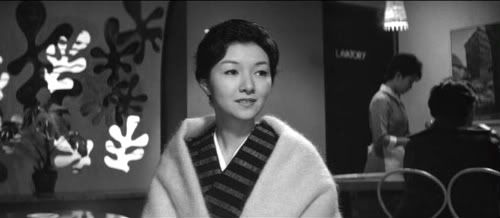
When a Woman... marks my sixth (and, for the moment, final) Naruse - and after traversing my way through the intimate small-town dramas that seem to dominate his 1950s work, this one came as a huge (but pleasant) surprise. From its very beginning, we're told that this will be something quite different: its credits are projected onto a black widescreen vista, accompanied by stark images and punctuated by Toshiro Mayuzumi's vibrant jazz score - thereby marking a notable contrast to the traditional grey introduction (complete with more classical imagery and melodramatic music) that normally opens Naruse's works. The director signifies that this will be a more modernist effort, and he spends the remainder of the film delivering on that promise. Its mish-mash of unrequited love and burning lust gives rise to a cluttered emotional panorama that seemingly marks Naruse's concerted attempt to engage with the afflictions of urban life. That life is rendered magnificently through his impeccable sets, which tend to centre on cosmopolitan bars or lead character Keiko's relatively sophisticated apartment, thereby reinforcing this break from the more homely interiors that Naruse admirers must've been accustomed to at this stage. And then there's the CinemaScope format, which Naruse milks for every inch of its worth. Some of the framing here brought to mind Michelangelo Antonioni, whose seminal L'Avventura was released this same year. Funky coincidence, huh? I actually think that comparison with Antonioni is useful because it's quite revealing... although Naruse's stylizations have effortlessly adapted to reflect his more modern surroundings (therefore allowing for such comparisons to be made), his thematics effectively remain the same and thus, in that distinctly Narusean way that I've come to adore, the director emphasizes the continuity of his standard preoccupations (thus refuting my Michelangelo comparison in the process).
With When a Woman..., Naruse once again shines his cinematic light on the rigidity of the social order and the difficulties that arise when attempting to 'break the mould', so to speak. The issue of female independence is typically at the forefront of his inquiries, and the plight of Keiko functions as a mirror on which to dramatize the conflicts that the thirst for autonomy creates. Although this perhaps makes the film sound more contrived than it deserves? Naruse is always (and I mean always) dedicated to observing his characters in all their naturalistic beauty, in order to genuinely recreate the wealth of human experience. So whilst a number of When a Woman...'s characters behave in ways that surprise us, the director ensures that the machinations of his screenplay remain concealed thanks to his unique ability to preserve that organic 'flow' which defines his best efforts.
And talking of 'flows', there's a similarity between this film and the earlier Flowing re: the way in which both deal with the subject of women as commodities. Obviously, this is more overt in the geisha house of the earlier film, but When a Woman... is shrouded by the issue of money and debt as well, and the glamorous images projected by the bar hostesses are stressed by Keiko as nothing more than mere 'performances' (a point that the film poignantly expands upon with both Keiko and supporting characters such as Yuri) conceived to maximise their monetary gain. The cost of Keiko's desired independence further augments the prevalence of transactions within the film, and the role of money (to purchase her own bar) and its relationship to the patriarchy (she needs patronage) is a central theme here. The film's opening segment establishes Keiko's dilemma: as an 'aging' (she's only 30!) woman in a disreputable profession, she is left with only two options - to open her own bar, or to enter into a doomed marriage (for no "decent" man would apparently desire a woman like her). In both cases, she's dependent upon the patriarchy, and although she tries to manipulate it to her own benefits by gaining capital from numerous patrons in an attempt to resist becoming possessed by a single one, the aforementioned 'organic flow' of Narusean life painfully catches up with her and underlines the difficulty of achieving one's dreams. As a woman, that is.
Keiko is in many ways too outdated for the bustling Ginza district in which she works. She's perhaps too virtuous and moralistic to ever run a truly thriving bar like her rival, Yuri (although, conversely, this adds to her 'appeal' for her clientele). We sense that, had she been born a few years earlier, she would've assumed the role of the antiquated geisha whom she offends during the film's final act, and whose purpose she is uncomfortably replicating in 1960s Japan. Still, the attribute that compels her to continue with her fight is that of perseverance and it's really this sense of endurance (in spite of the suffering) that the film ultimately leaves us with. Visually, the motif of "ascending the stairs" is an extension of this idea. One recalls her own distaste for her profession', yet still she climbs - as if by doing so she'll figuratively rise above jaded reality and towards spiritual harmony. The fact that each of these ascents leads only to the same objectification and 'performance' speaks volumes. It's a continuous cycle, and a ritual that culminates in one of the most poignant finales of a director's career that's seemingly full of them.
No comments:
Post a Comment